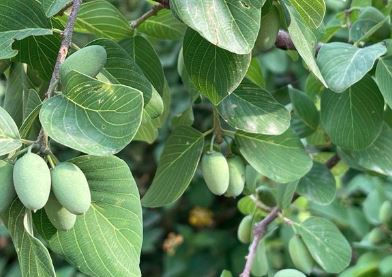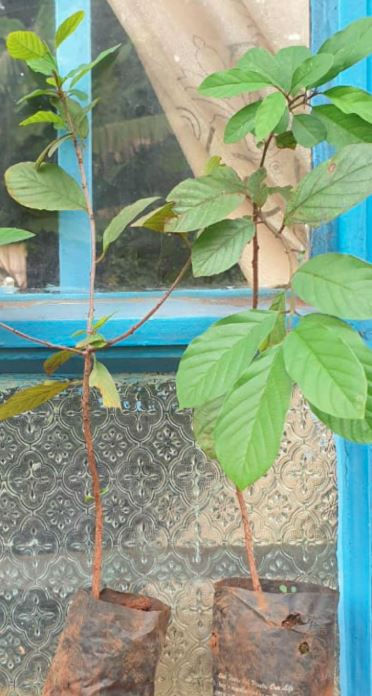Berchemia discolor (Bird Plum): Uses, Benefits, Identification
- BeyondForest

- May 5
- 5 min read
Updated: Nov 10

1.)About Berchemia discolor
2.)Local Names of Berchemia discolor
3.)Botanical Description of Berchemia discolor
Mnago is truly a treasure of the drylands! Amazing how one tree can offer food, medicine, and resilience in harsh climates.-Kimeli
Berchemia discolor, commonly known as Bird Plum or Wild Almond, is an indigenous semi-deciduous tree that plays an important ecological, cultural, and economic role across Kenya’s drylands. The tree typically grows 3 to 20 meters tall, forming a rounded, spreading crown with grey-black, cracked bark and shiny dark-green leaves that are sticky when young. Its fruits are small, oval, and fleshy—turning from green to yellow or reddish brown when fully ripe. These sweet, edible fruits are popular among communities, birds, and wildlife, making the tree an important source of dry-season nutrition.
also known as bird plum, brown ivory, or Eembe in Namibia
Image of Berchemia Discolor Seedling for sale by Patricia Makena
Beyond its edible fruits, Bird Plum provides firewood, charcoal, fodder, bee forage, and medicine, making it a valuable multipurpose species for dryland agroforestry. Its deep root system stabilizes soil, making it useful for erosion control, windbreaks, and shade in homesteads and farms.
It has a large seed in the center, surrounded by a thin layer of edible flesh they are sweet especially when they are almost dry-Captain Green Ke

Berchemia discolor plays a vital role in its ecosystem. Its leaves are browsed by various herbivores, including elephants, giraffes, kudus, bushbucks, impalas, and damara dik-diks.

The Berchemia discolor bark is dark grey and fissured, while young stems are pale green with brown lenticels. Leaves are opposite, simple, and elliptic to oblong, measuring 50–140 mm in length and 25–60 mm in width. They are shiny dark green on the upper surface and paler beneath, with a prominently raised midrib. Small greenish-yellow flowers appear in clusters within the leaf axils from October to January.
The fruit is an ovoid, fleshy drupe, yellow to pale orange when ripe, appearing from January to July. This species is widely distributed across Africa, from northern KwaZulu-Natal to Mpumalanga and Limpopo Provinces in South Africa, extending through Mozambique, Zimbabwe, Botswana, Namibia, Angola, Sudan, and Ethiopia. It thrives in low-altitude bushveld, often along riverbanks and on termite mounds.
The sweet fruits attract baboons, vervet monkeys, and numerous bird species such as louries, pigeons, starlings, barbets, and hornbills.
Brachemia Discolor Common Names

In Borana Language it is referred to as Jajab .In Swahili language it is known as Mkulu or Mnago. In English languageit is referred to as Bird plum , In Giriama Language it is referred to as Mkulu, gongo. In Kamba Language it is referred to as Kisaaya (Makueni) Kisanawa,nzanawa in Kitui,

In Mbeere language it is referred to as Muthwana ,In oromo language it is referred to as Jajab .In Pokot Language it is known as Muchukwo or Muchuk in Plural .In Rendile Language it is referred to as Santau. In Samburu Language it is referred to as Santaiti .In Somali Language it is referred to as Deen,Dheenden ro'o or Korguba .In Turkana Language it is referred to as Emeyan.In Taita Language it is referred to as mzoana.In Tugen language it is referred to as Muchukwa
Botanical Description of Berchemia discolor
Berchemia discolor is an indigenous semi-deciduous tree or shrub that ranges from 3 to 20 meters in height, forming a dense, rounded crown with gracefully spreading branches. The bark is grey to black, rough, and cracked, often showing scaly patches and corky spots on younger stems. Its leaves are shiny, dark green, and sticky when young, featuring distinct lateral veins and a reddish midrib and petiole. The tree produces small yellow-green flowers arranged in loose clusters, which later develop into oval fruits measuring 1–2 cm long. These fruits transition from green to yellow or reddish brown when ripe and contain one or two flat seeds.

Its sweet, nutritious fruits are eaten fresh and serve as an important food source for rural communities and wildlife during dry seasons.
The tree is widely used for firewood and charcoal, thanks to its dense, high-energy wood.
Its leaves and young shoots provide fodder for goats and livestock, particularly when pasture is scarce.
Berchemia discolor is also an excellent bee forage species, supporting honey production.
Traditionally, various parts of the tree are used for medicine, while its deep roots and strong structure make it ideal for soil conservation, windbreaks, shade, and ornamental planting around homesteads.
Berchemia discolor (Bird Plum) – Frequently Asked Questions
Berchemia discolor, commonly known as Bird Plum or Wild Almond, is an indigenous semi-deciduous shrub or tree that grows 3–20 meters tall. It is widely found in arid and semi-arid regions of Kenya.
What are the common names of Berchemia discolor in Kenya?
It has many local names including . Kisaaya (Kamba), Muthwana (Mbeere/Tharaka), Jajab (Orma/Borana), Mkulu/Mnago (Swahili), Kor’guba (Somali), Emeyan (Turkana), Muchukwo (Pokot).
Where does Berchemia discolor grow naturally?
It grows in dry regions between 0–1,600 m above sea level, especially in Eastern Kenya (Machakos, Makueni, Kitui), Rift Valley, and coastal Kenya. It prefers sandy, rocky, or alluvial soils.
Whether You’re in Farming, Tourism, Machinery, or Retail — We Help You Make Data-Driven Decisions.
Data Collection
Market Analysis
Dashboards
Price Monitoring
Hire Us Today>>>>>>
It has a grey-black cracked bark, shiny dark-green sticky leaves when young, small yellow-green flowers, and oval fruits that turn yellow to reddish brown when ripe.
When does Berchemia discolor flower and fruit?
Flowering occurs from February to March, fruit development takes 6–8 months, and seeds mature between August and October.
How do you collect and extract Berchemia discolor seeds?
Ripe reddish-brown fruits are hand-picked or shaken down into nets. Seeds are extracted by squeezing and washing the pulp, then sun-dried and cleaned.
How long can Bird Plum seeds be stored?
Seeds can be stored for up to 1 year in airtight containers placed in a cool, dry environment without major loss of viability.
No. The species does not require pre-sowing treatment. Seeds germinate within 30–50 days, with a germination rate of 20–40%.
What are the main uses of Berchemia discolor?
It is used for Firewood & charcoal, Edible fruits, Fodder, Bee forage, Medicinal uses, Soil conservation, Shade & windbreak and Ornamental purposes

Image of a Berchemia Discolor by MERA KO-OP
Is Berchemia discolor good for dryland agroforestry?
Yes. It is drought-tolerant, fast-growing in semi-arid regions, provides shade, stabilizes soils, and offers multiple income and nutrition benefits.
Does the tree have medicinal value?
Yes. Traditionally, various parts of the tree have been used for herbal remedies, though scientific validation varies.
How many seeds are in one kilogram?
One kilogram contains 2,300 – 3,500 seeds, and can produce up to 800 seedlings.














Comments